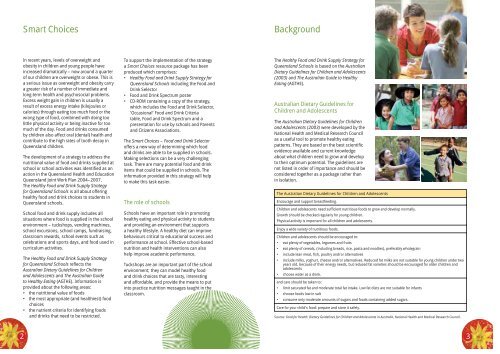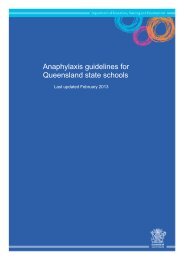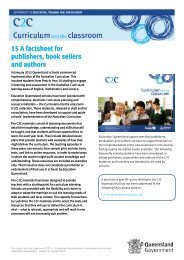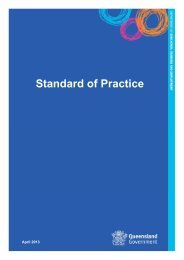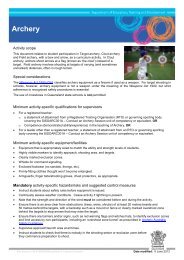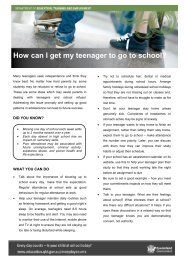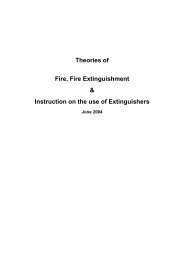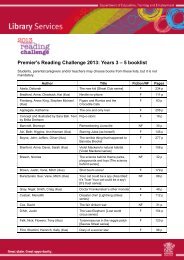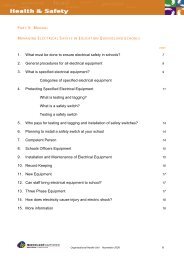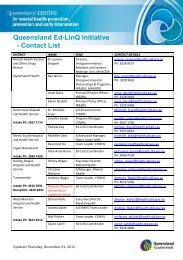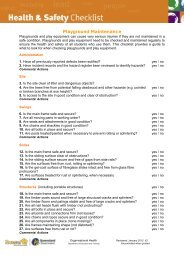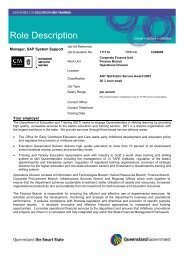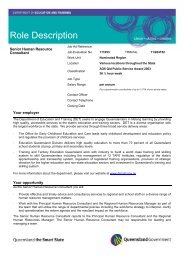Smart Choices - Healthy Food and Drink Supply Strategy for ...
Smart Choices - Healthy Food and Drink Supply Strategy for ...
Smart Choices - Healthy Food and Drink Supply Strategy for ...
You also want an ePaper? Increase the reach of your titles
YUMPU automatically turns print PDFs into web optimized ePapers that Google loves.
<strong>Smart</strong> <strong>Choices</strong><br />
In recent years, levels of overweight <strong>and</strong><br />
obesity in children <strong>and</strong> young people have<br />
increased dramatically – now around a quarter<br />
of our children are overweight or obese. This is<br />
a serious issue as overweight <strong>and</strong> obesity carry<br />
a greater risk of a number of immediate <strong>and</strong><br />
long-term health <strong>and</strong> psychosocial problems.<br />
Excess weight gain in children is usually a<br />
result of excess energy intake (kilojoules or<br />
calories) through eating too much food or the<br />
wrong type of food, combined with doing too<br />
little physical activity or being inactive <strong>for</strong> too<br />
much of the day. <strong>Food</strong> <strong>and</strong> drinks consumed<br />
by children also affect oral (dental) health <strong>and</strong><br />
contribute to the high rates of tooth decay in<br />
Queensl<strong>and</strong> children.<br />
The development of a strategy to address the<br />
nutritional value of food <strong>and</strong> drinks supplied at<br />
school or school activities was identified as an<br />
action in the Queensl<strong>and</strong> Health <strong>and</strong> Education<br />
Queensl<strong>and</strong> Joint Work Plan 2004–2007.<br />
The <strong>Healthy</strong> <strong>Food</strong> <strong>and</strong> <strong>Drink</strong> <strong>Supply</strong> <strong>Strategy</strong><br />
<strong>for</strong> Queensl<strong>and</strong> Schools is all about offering<br />
healthy food <strong>and</strong> drink choices to students in<br />
Queensl<strong>and</strong> schools.<br />
School food <strong>and</strong> drink supply includes all<br />
situations where food is supplied in the school<br />
environment – tuckshops, vending machines,<br />
school excursions, school camps, fundraising,<br />
classroom rewards, school events such as<br />
celebrations <strong>and</strong> sports days, <strong>and</strong> food used in<br />
curriculum activities.<br />
The <strong>Healthy</strong> <strong>Food</strong> <strong>and</strong> <strong>Drink</strong> <strong>Supply</strong> <strong>Strategy</strong><br />
<strong>for</strong> Queensl<strong>and</strong> Schools reflects the<br />
Australian Dietary Guidelines <strong>for</strong> Children<br />
<strong>and</strong> Adolescents <strong>and</strong> The Australian Guide<br />
to <strong>Healthy</strong> Eating (AGTHE). In<strong>for</strong>mation is<br />
provided about the following areas:<br />
the nutritional value of foods<br />
the most appropriate (<strong>and</strong> healthiest) food<br />
choices<br />
the nutrient criteria <strong>for</strong> identifying foods<br />
<strong>and</strong> drinks that need to be restricted.<br />
To support the implementation of the strategy<br />
a <strong>Smart</strong> <strong>Choices</strong> resource package has been<br />
produced which comprises:<br />
<strong>Healthy</strong> <strong>Food</strong> <strong>and</strong> <strong>Drink</strong> <strong>Supply</strong> <strong>Strategy</strong> <strong>for</strong><br />
Queensl<strong>and</strong> Schools including the <strong>Food</strong> <strong>and</strong><br />
<strong>Drink</strong> Selector<br />
<strong>Food</strong> <strong>and</strong> <strong>Drink</strong> Spectrum poster<br />
CD-ROM containing a copy of the strategy,<br />
which includes the <strong>Food</strong> <strong>and</strong> <strong>Drink</strong> Selector,<br />
‘Occasional’ <strong>Food</strong> <strong>and</strong> <strong>Drink</strong> Criteria<br />
table, <strong>Food</strong> <strong>and</strong> <strong>Drink</strong> Spectrum <strong>and</strong> a<br />
presentation <strong>for</strong> use by schools <strong>and</strong> Parents<br />
<strong>and</strong> Citizens Associations.<br />
The <strong>Smart</strong> <strong>Choices</strong> – <strong>Food</strong> <strong>and</strong> <strong>Drink</strong> Selector<br />
offers a new way of determining which food<br />
<strong>and</strong> drinks are able to be supplied in schools.<br />
Making selections can be a very challenging<br />
task. There are many potential food <strong>and</strong> drink<br />
items that could be supplied in schools. The<br />
in<strong>for</strong>mation provided in this strategy will help<br />
to make this task easier.<br />
The role of schools<br />
Schools have an important role in promoting<br />
healthy eating <strong>and</strong> physical activity to students<br />
<strong>and</strong> providing an environment that supports<br />
a healthy lifestyle. A healthy diet can improve<br />
behaviours critical to educational success <strong>and</strong><br />
per<strong>for</strong>mance at school. Effective school-based<br />
nutrition <strong>and</strong> health interventions can also<br />
help improve academic per<strong>for</strong>mance.<br />
Tuckshops are an important part of the school<br />
environment; they can model healthy food<br />
<strong>and</strong> drink choices that are tasty, interesting<br />
<strong>and</strong> af<strong>for</strong>dable, <strong>and</strong> provide the means to put<br />
into practice nutrition messages taught in the<br />
classroom.<br />
Background<br />
The <strong>Healthy</strong> <strong>Food</strong> <strong>and</strong> <strong>Drink</strong> <strong>Supply</strong> <strong>Strategy</strong> <strong>for</strong><br />
Queensl<strong>and</strong> Schools is based on the Australian<br />
Dietary Guidelines <strong>for</strong> Children <strong>and</strong> Adolescents<br />
(2003) <strong>and</strong> The Australian Guide to <strong>Healthy</strong><br />
Eating (AGTHE).<br />
Australian Dietary Guidelines <strong>for</strong><br />
Children <strong>and</strong> Adolescents<br />
The Australian Dietary Guidelines <strong>for</strong> Children<br />
<strong>and</strong> Adolescents (2003) were developed by the<br />
National Health <strong>and</strong> Medical Research Council<br />
as a useful tool to promote healthy eating<br />
patterns. They are based on the best scientific<br />
evidence available <strong>and</strong> current knowledge<br />
about what children need to grow <strong>and</strong> develop<br />
to their optimum potential. The guidelines are<br />
not listed in order of importance <strong>and</strong> should be<br />
considered together as a package rather than<br />
in isolation.<br />
The Australian Dietary Guidelines <strong>for</strong> Children <strong>and</strong> Adolescents<br />
Encourage <strong>and</strong> support breastfeeding.<br />
Children <strong>and</strong> adolescents need sufficient nutritious foods to grow <strong>and</strong> develop normally.<br />
Growth should be checked regularly <strong>for</strong> young children.<br />
Physical activity is important <strong>for</strong> all children <strong>and</strong> adolescents.<br />
Enjoy a wide variety of nutritious foods.<br />
Children <strong>and</strong> adolescents should be encouraged to:<br />
eat plenty of vegetables, legumes <strong>and</strong> fruits<br />
eat plenty of cereals, (including breads, rice, pasta <strong>and</strong> noodles), preferably wholegrain<br />
include lean meat, fish, poultry <strong>and</strong>/or alternatives<br />
include milks, yoghurt, cheese <strong>and</strong>/or alternatives. Reduced fat milks are not suitable <strong>for</strong> young children under two<br />
years old, because of their energy needs, but reduced fat varieties should be encouraged <strong>for</strong> older children <strong>and</strong><br />
adolescents<br />
choose water as a drink.<br />
<strong>and</strong> care should be taken to:<br />
limit saturated fat <strong>and</strong> moderate total fat intake. Low fat diets are not suitable <strong>for</strong> infants<br />
choose foods low in salt<br />
consume only moderate amounts of sugars <strong>and</strong> foods containing added sugars.<br />
Care <strong>for</strong> your child’s food: prepare <strong>and</strong> store it safely.<br />
Source: <strong>Food</strong> <strong>for</strong> Health: Dietary Guidelines <strong>for</strong> Children <strong>and</strong> Adolescents in Australia, National Health <strong>and</strong> Medical Research Council.<br />
2 3


